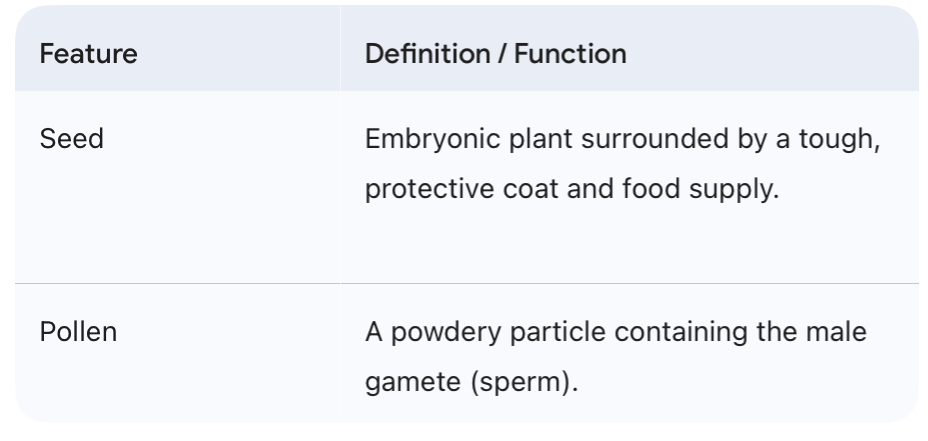plant diversity 2

1. Features of a seed that ensure survival and growth:
The seed helps ensure the embryo's survival and development by providing:
• A tough, protective coat to prevent the embryo from drying out.
• A food supply (storage tissue/endosperm) that provides energy for the embryo's early life and germination.
2. Seed Parts and Function:
| Part | Function/Development |
| :--- | :--- |
| Seed coat | The tough, protective outer layer. |
| Food supply (Storage Tissue/Endosperm) | Provides nutrients for the developing embryo. |
| Cotyledons | Parts of the embryo; store food in some seeds (known as "seed leaves"). |
| Hypocotyl/Epicotyl | Parts of the embryo; develop into the stem and leaves of the plant shoot. |
| Radicle | The embryonic root; develops into the primary root of the plant. |
3. How does pollen allow plants to be better adapted to life on land?
The evolution of pollen was a major adaptation because it meant that water is no longer required for reproduction/sperm transmission. Pollen can be distributed via wind or animals.
II. Gymnosperms
4. Name the four major groups of gymnosperms:
1. Conifers
2. Gingkos
3. Cycads
4. Gnetophytes
5. What two major adaptations separate Gymnosperms from seedless vascular plants?
The two major adaptations that distinguish the seed plants (starting with Gymnosperms) are Seeds and Pollen.
6. Which life stage is dominant in the gymnosperm life cycle?
The Sporophyte (2N) stage is dominant.
7. Location of Gametophytes:
• Male gametophyte: Found within the pollen.
• Female gametophyte: Found within the ovule (which is located inside the female cone).
8. Why do gymnosperms produce so much pollen?
Gymnosperms are typically wind-pollinated. Wind pollination is less efficient and random compared to animal pollination, so the plants must produce a massive volume of pollen to ensure that some of it successfully reaches a female cone.
III. Angiosperms
9. What is an angiosperm? What two features make them distinct?
• Definition: Angiosperm means "covered seed". They are also known as "Flowering Plants".
• Distinct Features: They are the only plants that produce flowers and fruit (which surrounds the seed).
10. Features of Monocots and Dicots:
| Feature | Monocots | Dicots (Eudicots) |
| :--- | :--- | :--- |
| Cotyledons (Seed leaves) | 1 cotyledon | 2 cotyledons |
| Leaf Veins | Parallel veins | Netted (branching) veins |
| Vascular Bundles in Stem | Scattered throughout the stem | Arranged in a ring in the stem |
| Root Type | Fibrous roots | Taproots |
| Flower Petals | Petals in multiples of 3's | Petals in multiples of 4's or 5's |
11. Monocot products that humans rely on:
Examples include grass, rice, corn, bananas, pineapples, and lilies.
12. Dicot products that humans rely on:
• Most trees are dicots.
• Most fruits that humans enjoy come from dicots.
• Most plants seen in flower gardens are dicots.
13. What has allowed for such high diversity of angiosperms?
The high diversity is due to diverse associations with animals. This involves:
1. Flowers: Many are animal-pollinated.
2. Fruit: Many require animals to disperse their seeds (by eating the fruit and then pooping or spitting the seeds out).
This co-evolution allows for many different adaptations selected by specific animal pollinators and seed dispersers.
14. What is pollination? How do animals aid in this process?
• Pollination: The movement of pollen (which contains the sperm) from an anther to a stigma.
• Animal Aid: Flowers act as adaptations to attract and reward insect visitors (or other animals) who unknowingly transfer pollen while foraging for food (nectar).
15. Benefits of animal pollination vs. wind pollination:
| Benefit of Animal Pollination | Explanation |
| :--- | :--- |
| Less Pollen Needed | Since animal pollination is less "random" than wind (pollinators move directly from flower to flower), less pollen is required. |
| Promotes Cross-Pollination | Pollinators encourage mating between different individuals, which increases genetic diversity, over self-pollination. |
| Species Selectivity | Pollinator transfer increases the likelihood of a plant receiving pollen from its own species (more selective than wind). |
| Long-Distance Mating | Animals can carry pollen longer distances than wind, making long-distance mating possible. |
16. Which life stage is dominant in the angiosperm life cycle?
The Sporophyte (2N) stage is dominant.
17. Functions of Flower Parts:
| Flower Part | Function |
| :--- | :--- |
| Anther | Part of the stamen; responsible for producing pollen. |
| Filament | Part of the stamen; stalk that supports the anther. |
| Stigma | The top, receptive part of the pistil; where pollen lands and sticks. |
| Style | Part of the pistil; stalk connecting the stigma to the ovary. |
| Ovary | The base of the pistil; contains the ovules and develops into the fruit. |
| Petal | Often brightly colored and showy; primary function is to attract pollinators. |
| Sepal | Leaf-like structures at the base of the flower; protect the flower bud before it opens. |
18. Ways flowering plants attract pollinators and deceptive pollination:
• Attraction Methods:
• Offer a reward (usually nectar/sugar).
• Advertise the reward with bright colors, showy flowers, and sweet scents.
• Some plants use less appealing scents, like those that smell like rotting meat, to attract fly pollinators (e.g., Staphelia and Rafflesia arnoldii).
• Deceptive Pollination: This is when some flowers offer no reward but "trick" their pollinators into visiting and transferring pollen (e.g., some orchids).
19. What part of the flower develops into a fruit?
The ovary develops into the fruit as the seeds mature.
20. What is the function of fruits?
The primary function of fruits is to enclose and protect the seed. Once mature, the fruit aids in seed dispersal (e.g., by being eaten by animals or dispersed by wind, as with the milkweed pod).